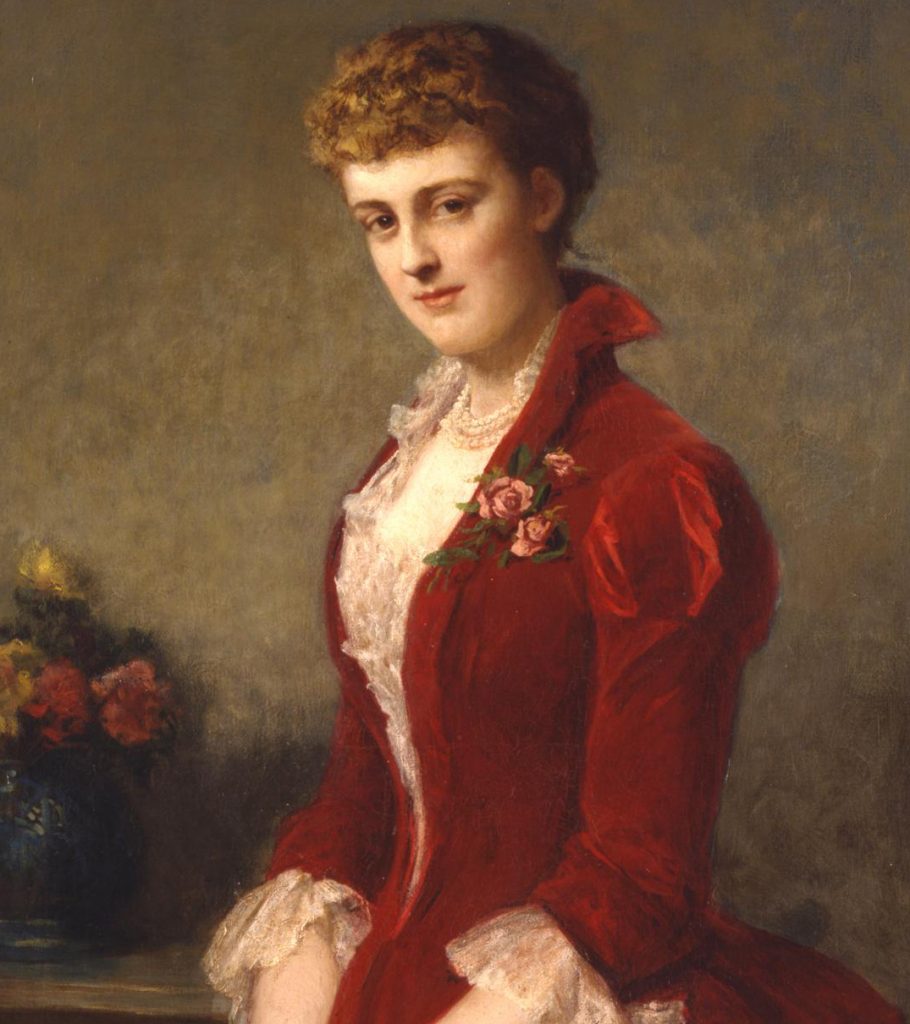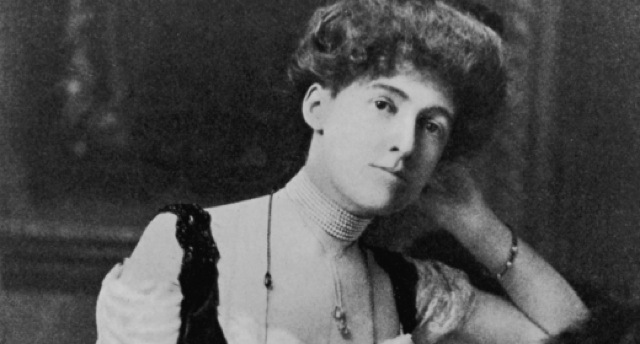American novelist Edith Wharton was the first female to win a Pulitzer Prize for her novel The Age of Innocence in 1921. In 1927, 1928, and 1930, she was nominated for the Nobel Prize in Literature, but did not win any of the three years. She wrote many humorous novels and short stories about the privileged upper class in America.
On January 24, 1862, Edith Newbold Jones was born in New York at 14 West Twenty-third Street to George Frederic and Lucretia Stevens Rhinelander Jones. She was the youngest of their three children (Frederic Rhinelander was sixteen at the time of her birth and Henry Edward was eleven). On April 20, 1862, she was baptized at Grace Church on Easter Sunday. Growing up, young Edith Jones’ family called her “Pussy Jones”. It is also said that the phrase “keeping up with the Joneses” is a reference to her father’s family. Jones was also very close with Beatrix Farrand, her brother Frederic Rhinelander daughter, though Beatrix was ten years her junior.
When Edith Jones was three, the South surrendered in the Civil War in 1865. With the war finally at an end, the Jones family began travelling throughout Europe. In 1866 they left for a six year trip (lasted until 1872) to France, Germany, Italy, and Spain. After spending extensive amounts of time in these countries, she had become fluent in French, German, and Italian. While in Germany in the Black Forest, the family was staying at a spa and Edith came in contact with typhoid fever. Various tutors and governesses educated her in Europe. Upon their return home in 1872, they began spending summers in Newport, Rhode Island and winters back home in New York.
Edith did not accept the high standards of young girls’ etiquette and fashion off the time with the purpose of marrying the daughter off and showing her off at balls and parties. However, she believed these were superficial and oppressive requirements and did not always conform to them. Along with that, Edith also wished for a better education than she was given, especially since girls of her time did not always receive the best education. In order to do this, Edith would read books from her father and his friends’ libraries. An obstacle came in the way though when her mother forbade her reading novels until she was married, an order that she complied with.
At a young age, Edith was already writing both fiction and poetry. At eleven years old, she attempted to write her first novel. Her first published work was when she was fifteen and she translated Heinrich Karl Brugsch’s German poem “Was die Steine Erzählen”, which translates into “What the Stones Tell”. Her family wished for her name to be hidden from print because at the time, the only occasions that an upper class woman’s name was to be printed was in the event of births, marriages, and deaths. Instead, her father’s friend, E. A. Washburn, put his name on the translation. Washburn, who was also Ralph Waldo Emerson’s cousin, played an important part in Edith’s education, encouraging her to continue pursuing an education and writing.
In 1877 when she was fifteen, Edith also wrote a novella called “Fast in Loose” in secret that was about 30,000 words long. The following year, her father arranged for his daughter to have two dozen original poems and five translations published privately. Then, in 1880, she anonymously published five poems in famous literary magazine of the time, the Atlantic Monthly. Although these early publications were successful, her family and friends did not encourage her to keep writing. She kept writing, but did not publish her next poem until 1889, “The Last Giustiniana” in Scribner’s Magazine.
For two years, Edith courted Henry Stevens and the two got engaged. For some reason though, the engagement came to an abrupt end in 1882 in the month they were to be married.
Three years later, Edith Jones married Edward “Teddy” Robbins Wharton on April 29, 1885 when she was twenty-three. He was twelve years her senior and came from a well-established, upper class Bostonian family. The couple shared a love for travelling as well and often traveled to Europe together. However, he suffered from acute depression from the late 1880s until 1902 and they did not travel during that time. By 1902, his depression only worsened and the couple lived an almost exclusive live at their estate The Mount in Massachusetts. When his state was determined incurable in 1908, Wharton began an affair with a journalist named Morton Fullerton. After they were married for twenty-eight years, Wharton divorced her husband in 1913.
On top of her novels, short stories, and poems, Wharton also published works about her love for garden and interior design. The first was her first published book called The Decoration of Houses in 1897, which was written with Ogden Codman. In 1904, she also published Italian Villas and Their Gardens.
Wharton’s love for travelling and wanderlust was first sparked when she travelled to Europe when she was four years old. Her father had passed his love for travelling down to his daughter. By the time she died, Wharton had crossed the Atlantic sixty times. She mainly travelled to Italy, France, and England, but visited other European countries as well and once went to Morocco in North Africa. Many of her books were about her travels.
For many years, Wharton and her husband, Edward Wharton, would spend the at least four months each year in Europe. For the most part, they stayed in Italy. Egerton Winthrop, the couple’s good friend, often accompanied them to Italy. In 1888 when she was twenty-six, their friend James Van Alen accompanied them on a four month long cruise through the Aegean Islands that cost them $10,000. Throughout the cruise, she kept a travel journal that was presumed lost until it was published as The Cruise of the Vanadis and is her earliest known travel piece.
Wharton purchased a home in Newport, Rhode Island called Land’s End in 1897. She spent thousands of dollars redoing the “incurably ugly” home that she had bought for $80,000. In 1902, she began designing her Lenox, Massachusetts estate, The Mount. Many of her novels were written there as well, including her famous The House of Mirth, published in 1905. Wharton entertained many at The Mount, her good friend and novelist Henry James included. While her husband’s state of depression worsened, she continued to travel for much of the year, but with her friend Egerton Winthrop. Up until 1911, The Mount was her permanent residence. Since her marriage was worsening, she decided to leave for France permanently and moved into an apartment at 53 Rue de Varenne in Paris for some time.
World War I broke out just as Wharton was preparing to leave that summer on vacation. Many people fled Paris, but instead, she went back to her apartment in the city and stayed there for four years as a supporter of France’s efforts in the war. In August of 1914, for example, she opened a workroom for unemployed woman where she pain them one franc a day. At first, thirty women worked for her, but soon the number doubled and the business thrived. That fall, Belgium was invaded by Germany and many Belgians took refuge in Paris. Then, Wharton set up American Hostels for the refugees, providing them with food, shelter, clothes, and an employment agency so they could find work. Wharton was able to collect over $100,000 to aid the refugees. She also organized the Children of Flanders Rescue Committee, a shelter for around 900 Belgian refugees that had been bombed by the Germans, in early 1915.
Wharton and her friend Walter Berry, who was the president of the American Chamber of Commerce in Paris at the time, were some of the few foreigners in France permitted to travel up to the front lines during the war. Between February-August of 1915, the two of them made five journeys together. They drive through the war zones, viewing each decimated village. Wharton even visited the trenches, sometimes in earshot of artillery fire. She described her experiences in a series of articles for Scribner’s Magazine called Fighting France: From Dunkerque to Belfort. The series was an instant bestseller back in America.
The French president appointed her Chevalier of the Legion of Honour, which was the highest award in the country, for all her hard work and dedication helping out refugees, the unemployed, and the injured.
In 1915, Wharton also edited a collection of essays, poetry, musical scores, and art written by many major artists of the time from America and Europe. When she proposed the book to her publisher, she worked hard to translate French entries into English, lined up contributors, and was in charge of all business arrangements. Former President Theodore Roosevelt even wrote an introduction for the collection, prising Wharton and her war efforts. During the war, alongside all her charity work, Wharton still continued to write. She worked on her novels, short stories, and poems and sometimes reported for the New York Times while still keeping up with her long list of correspondence. Before America entered the war, she encouraged Americans to support the war and encourage their country to do so. In 1916, she wrote her popular romantic novel called Summer and in 1918 the war novella called The Marne. The following year, she wrote A Son at the Front, which wasn’t published for four more years in 1923.
Wharton staunchly supported French imperialism, a “rabid imperialist” she called herself. Her political views were only solidified by the war.
When the war finally ended, Wharton decided to leave Paris to live in the countryside in a town ten miles north of the city called Saint-Brice-sous-Forêt. She bought an eighteenth century home that was on seven acres of land. Wharton called it Pavillon Colombe. For the rest of her life, she spent her summers and autumns their, the winters and springs st Sainte Claire du Vieux Château, Hyères on the French Riviera. After the war, she spent some time in Morocco as Resident General Hubert Lyautey’s guest. There she wrote a book about her experiences called In Morocco. In 1920, she finished The Age of Innocence, the book she won the Pulitzer Prize for. It takes place in New York around the city’s upper-class during the Gilded Age of the 1870s. She won the Pulitzer Prize in 1921, the first woman to ever do so.
It wasn’t until Yale University awarded her with an honorary doctorate degree in 1923 that she returned to America. That was the final time she would ever go back.
In 1934, an autobiography called A Backward Glance.
Wharton was at Ogden Codman’s country home in France working on their revised edition of The Decoration of Houses on June 1, 1937 when she collapsed from a heart attack. On August 11, 1937, Edith Jones Wharton died of a stroke at her home called Le Pavillon Colombe with her friend Royall Tyler at her bedside. Today, the street where her home was located is called rue Edith Wharton. She was buried in Versailles in the American Protestant section of the Cimetère des Gonards.




